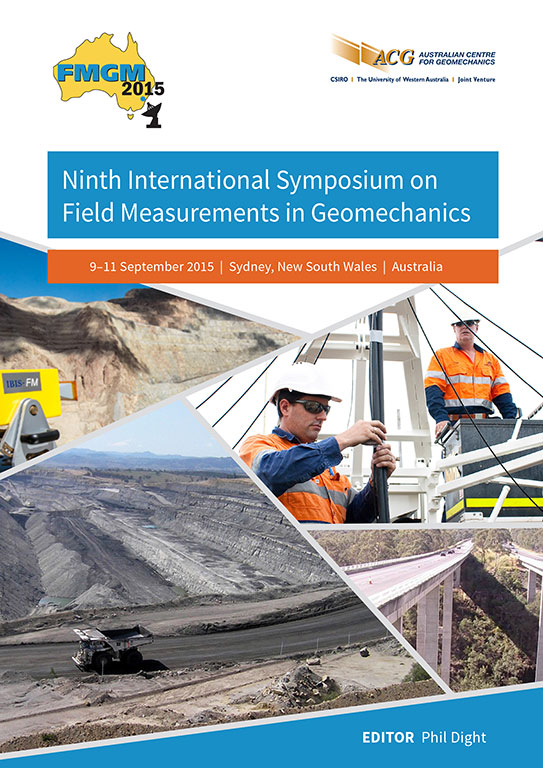Earthworks — if stiffness is important specify and test for it

|
Authors: Piccolo, D; Mostyn, G |
DOI https://doi.org/10.36487/ACG_rep/1508_36_Piccolo
Cite As:
Piccolo, D & Mostyn, G 2015, 'Earthworks — if stiffness is important specify and test for it', in PM Dight (ed.), FMGM 2015: Proceedings of the Ninth Symposium on Field Measurements in Geomechanics, Australian Centre for Geomechanics, Perth, pp. 527-538, https://doi.org/10.36487/ACG_rep/1508_36_Piccolo
Abstract:
Civil and geotechnical engineers routinely develop specifications for earthworks associated with civil structures (industrial warehouses, buildings, embankments, pavements, dams, reinforced earth retaining walls etc.) with the intention usually of controlling the stiffness and strength of the material in its as placed condition. This paper focuses on the stiffness of the landform resulting from the earthworks, where the term stiffness is used to describe the deformation behaviour of the material when subjected to loading. It is the authors’ experience that the indirect methods of controlling stiffness rely on a combination of material, placement, compaction, moisture and earthworks control requirements. Furthermore, such requirements do not, under all circumstances, control the in situ stiffness of the soil. This in turn can result in earthworks requirements being specified which are not necessary to result in adequate stiffness i.e. over specification; or earthworks requirements which do not necessarily result in adequate stiffness being specified, i.e. under specification. Furthermore, the typical earthworks specification has not changed much in 40 years, yet the typical performance requirements for superstructures supported on the earthworks have changed. On this basis, what in the past may have been ‘stiff enough’, may not be adequate and then for other uses may be grossly over specified. It is the authors’ opinion that the above issues can be addressed by direct measurement of the stiffness. Such measurements need to be understood within the limitations of characterising complex soil behaviour using simple models, e.g. elastoplasticity. This paper presents six case studies where direct measurement of stiffness assisted the authors in addressing the limitations discussed above. Further, it presents results of stiffness measurements taken by means of plate load testing, settlement plates, large-scale oedometers and large-scale loading tests. The authors hope that the paper will encourage practitioners to ‘specify and test for stiffness where it matters’.
References:
American Society for Testing and Materials 1997, D1196-93: Standard Test Methods for Non-Repetitive Static Plate Load Tests of Soils and Flexible Pavement Components, For Use in Evaluation and Design of Airport and Highway Pavements, ASTM, West Conshohocken, PA.
Burman, BC, Mostyn, G & Piccolo, D 2008, ‘Experiences with post-construction re-testing of engineered clay fills’, Australian Geomechanics, vol. 43, no. 4, 30 p.
Highways Agency & BRE 2007, Development of Performance Specifications for Earthworks - Phase 2 – Links between air voids content and performance of completed embankments: final report, prepared by H Skinner & A Phear, 69 p.
Howard, AK 1977, ‘Modulus of soil reaction values for buried flexible pipe’, Journal of the Geotechnical Engineering, vol. 103, no. GT1, New York, NY.
Howard, AK 2006, ‘The reclamation E table, 25 years later’, Proceedings of the 13th Plastics Pipe International Conference, 11 p.
McGrath, TJ 1998, ‘Replacing E′ with the constrained modulus in flexible pipe design’, in JP Casteonovo & JA Clark (eds), Proceedings of the Pipeline Division Conference, American Society of Civil Engineers, Reston ,VA, pp. 28-40.
Piccolo, D & Mostyn, G 2006, ‘Engineering issues relating to filling of deep pits for residential and light industrial development’, Proceedings of the 7th ANZ Young Geotechnical Professionals Conference.
Selig, ET 1990, ‘Soil properties for plastic pipe installations’, in GS Buczala & MJ Cassady (eds), Buried plastic pipe technology, ASTM STP1093, American Society for Testing and Materials, Philadelphia, PA, pp. 141-158.
Shen, B & Mostyn, G 2012, ‘Characterisation of structural fills for industrial developments’, Proceedings of the Australian – New Zealand Conference on Geomechanics, pp. 883-888.
Standards Australia 1998, AS/NZS 2566.1: Buried Flexible Pipelines, Standards Australia, Sydney.
Standards Australia 2007, AS3798: Guidelines on Earthworks for Commercial and Residential Developments, Standards Australia, Sydney.
© Copyright 2025, Australian Centre for Geomechanics (ACG), The University of Western Australia. All rights reserved.
View copyright/legal information
Please direct any queries or error reports to repository-acg@uwa.edu.au
View copyright/legal information
Please direct any queries or error reports to repository-acg@uwa.edu.au